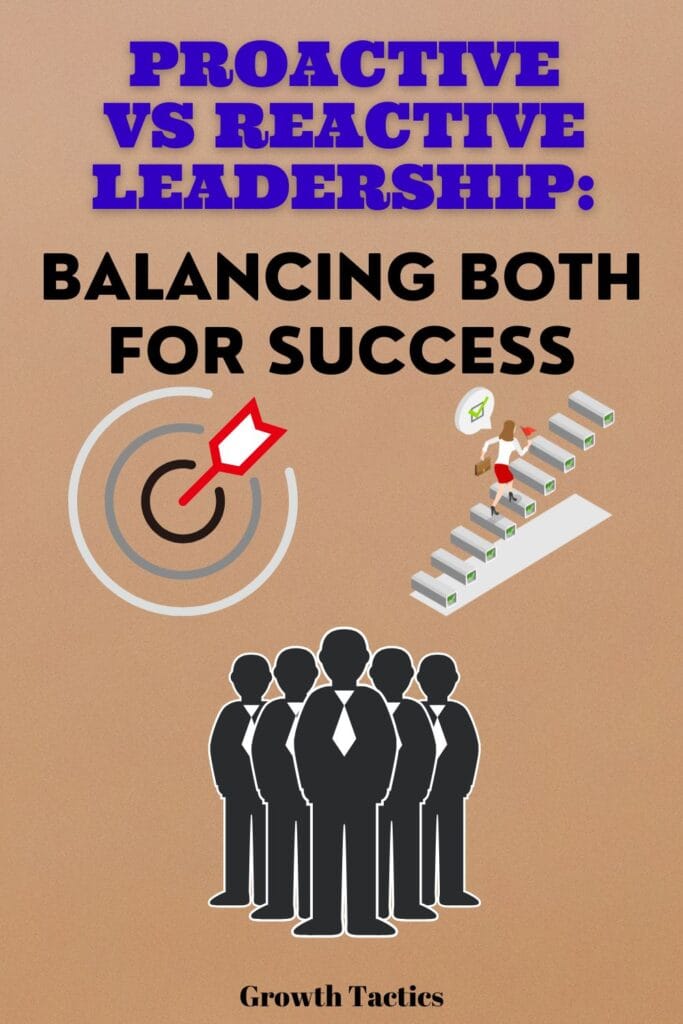Imagine two captains steering their ships through a storm. One scans the horizon, plotting a course to avoid the worst of the tempest. The other grips the wheel tightly, ready to react to each crashing wave. Which captain would you trust with your journey?
In the world of leadership, we face a similar choice between proactive and reactive styles. But here’s the twist, the most successful leaders don’t choose one or the other. They master both.
In this article, we’ll explore how balancing proactive and reactive leadership can steer your organization to success, no matter what storms you face. Buckle up, because we’re about to embark on a journey that will transform your understanding of effective leadership.
Jump To Section
Understanding Proactive Leadership
Let’s talk about proactive leadership. Imagine a leader who doesn’t just wait for problems to pop up but actively looks for ways to make things better. That’s proactive leadership in a nutshell.
What is Proactive Leadership?
Proactive leaders are like chess players. They think several moves ahead. They don’t just react to what’s happening now; they anticipate future challenges and opportunities. These leaders take charge, make plans, and act before they have to.
Benefits of Proactive Leadership
Being proactive comes with some serious perks:
- Prevention: It helps prevent problems before they start.
- Positive Environment: It creates a work environment where people feel prepared and confident.
- Better Decision-Making: It leads to better decisions because you’re not always in crisis mode.
- Increased Productivity: It boosts productivity as you’re always looking for ways to improve.
When to Use Proactive Leadership
Proactive leadership shines in many situations:
- When planning long-term strategies
- During periods of organizational change
- In competitive industries where innovation is key
- When building strong, resilient teams
Examples of Proactive Leaders
Let’s look at some real-world proactive leaders:
- Elon Musk: He’s always thinking ahead, whether it’s electric cars or space travel.
- Mary Barra of General Motors: She’s steered GM towards electric vehicles before regulations demanded it.
- Jeff Bezos: He transformed Amazon from an online bookstore to a tech giant by anticipating future trends.
Tips for Becoming a More Proactive Leader
Want to up your proactive game? Try these tips:
- Set Clear Goals: Know where you’re headed so you can plan the journey.
- Stay Informed: Keep up with industry trends and changes.
- Encourage Feedback: Your team might spot opportunities you’ve missed.
- Practice Scenario Planning: Think “What if?” and prepare for different outcomes.
- Take Calculated Risks: Don’t be afraid to try new things.
- Invest in Your Team: Develop their skills to handle future challenges.
Remember, being proactive doesn’t mean you can predict the future. It’s about being prepared, staying ahead of the curve, and creating opportunities rather than just responding to them. So, are you ready to take the lead?
Understanding Reactive Leadership
Have you ever seen a firefighter in action? They rush to the scene, assess the situation, and take immediate steps to control the blaze. This is a lot like reactive leadership.
What is Reactive Leadership?
Reactive leaders excel in handling things as they come. They respond to events and challenges in the moment. While they may not have seen every problem coming, they are quick on their feet and ready to tackle whatever pops up. Think of them as expert problem-solvers who thrive under pressure.
The Value of Reactive Leadership
Reactive leadership isn’t just about putting out fires; it has its own set of benefits:
- Immediate Response: Reactive leaders can quickly address urgent issues, minimizing damage.
- Flexibility: They adapt well to changing circumstances.
- Crisis Management: These leaders are great in emergencies because they stay calm and focused.
- Quick Decision-Making: They make decisions on the spot, keeping things moving.
When Reactive Leadership Works Best
There are situations where reactive leadership is exactly what you need:
- During crises or emergencies
- In customer service roles where immediate responses are crucial
- When unexpected changes occur
- In high-paced environments where circumstances change rapidly
Examples of Reactive Leaders
Let’s check out some reactive leaders who have made a difference:
- Winston Churchill during WWII: He made quick, crucial decisions to steer the UK through the war.
- Howard Schultz: The CEO of Starbucks responded swiftly during the 2008 financial crisis to revamp the brand and keep the company afloat.
- Indra Nooyi: As the former CEO of PepsiCo, she navigated the company through significant market shifts and challenges.
Tips for Mastering Reactive Leadership
Want to be better at reactive leadership? Here are some tips:
- Stay Calm Under Pressure: Practice staying composed in stressful situations.
- Be Decisive: Trust your instincts and make quick decisions.
- Learn Continuously: Keep updating your knowledge so you’re prepared for unexpected challenges.
- Build Strong Relationships: Know your team well so you can rely on them in a pinch.
- Improve Communication: Clear and effective communication helps in quickly addressing problems.
- Prepare for the Unexpected: While reactive leadership handles the unexpected, being generally prepared can still make a huge difference.
Reactive leadership is all about managing the unexpected with grace and efficiency. While it may seem like you’re always playing catch-up, being a strong reactive leader means you can handle surprises and keep things running smoothly. So, are you ready to react with confidence?
Comparing Proactive and Reactive Leadership Styles
Proactive Leaders are the planners. They look into the future, anticipate challenges, and set strategies in motion to tackle problems before they even arise. It’s like plotting a course before setting sail.
Reactive Leaders are the responders. They deal with issues as they come up, making quick decisions to manage situations effectively. They’re the ones you call when the ship hits rough waters.
The Importance of Balancing Both Styles
Imagine trying to navigate a busy highway. Sometimes you need to plan your route in advance to avoid traffic (proactive), and other times you need to swerve to avoid a sudden obstacle (reactive). In leadership, both approaches are crucial. Balancing these styles can make a world of difference in how smoothly your team moves forward.
When you balance proactive and reactive leadership, you stay prepared. Planning ahead means you can foresee potential problems and set strategies to tackle them. This foresight helps you and your team feel more in control. Even when unexpected issues pop up, your team can handle them better because they know you’ve got their back with a solid plan.
Flexibility is another big win from balancing these styles. Being proactive helps you set clear goals and strategies, but life isn’t always predictable. Quick changes, market shifts, or sudden challenges can disrupt even the best-laid plans. That’s where reactive leadership steps in. It lets you adapt swiftly, keeping your team agile and ready to pivot as needed.
Managing stress is easier when you balance both leadership styles. Proactive planning reduces the chances of being caught off guard, lowering overall stress levels. When unexpected issues do arise, being skilled at reactive leadership ensures you handle them efficiently, preventing small hiccups from becoming bigger problems. Your team will appreciate knowing that their leader can both guide them with a clear vision and respond adeptly to immediate challenges.
Boosting team morale also comes from this balance. Your team wants to follow someone who can see ahead but also be present in the moment. By demonstrating that you can plan strategically and react effectively, you build trust and confidence within your team. They know you’re capable of navigating both routine operations and sudden crises, making them more willing to invest in the journey ahead.
Balancing proactive and reactive leadership styles is like having a well-rounded toolkit. It equips you to tackle any challenge, planned or unplanned, ensuring your team moves forward confidently and smoothly. So, embrace both styles, stay prepared, and lead with flexibility and confidence.
Strategies for Developing a Balanced Leadership Approach
Finding the right mix between proactive and reactive leadership can feel like a tricky balancing act. But with some practical strategies, you can master both styles and lead your team more effectively. Here are some easy-to-follow tips:
Assess Each Situation
Start by understanding what the moment calls for. Is it time to think ahead and lay out a plan (proactive)? Or do you need to jump in and handle a problem right now (reactive)? For example, use proactive thinking during strategy meetings but switch to reactive mode if a key client calls with an urgent issue.
Build a Diverse Team
Having team members with different strengths helps a lot. Some people may excel in planning and forecasting, while others thrive in fast-paced, problem-solving situations. This diversity ensures you’re ready for anything, whether it’s a planned project or an unexpected crisis.
Set Clear Goals
Outline where you’re headed with long-term goals. Share this vision with your team so everyone knows the plan. But also be clear that sometimes plans change, and that’s okay. This prepares everyone to stay flexible and ready to adapt.
Communicate Effectively
Keep the lines of communication open. Regularly update your team on the proactive strategies you’re working on and be transparent about any sudden changes that require quick action. Good communication makes everyone feel involved and informed.
Practice Flexibility
Make it a habit to run through different scenarios. Conduct drills or discussions where your team has to react to various situations. This practice builds confidence and improves everyone’s ability to think on their feet.
Gather Feedback
After dealing with a situation, take time to reflect on what went well and what could improve. Ask your team for their input. This feedback loop helps refine your proactive plans and reactive responses over time.
Train for Both Styles
Encourage your team to engage in training that covers both strategic planning (proactive) and crisis management (reactive). Sessions can include workshops, online courses, or real-time simulations to build these skills.
Leverage Technology
Use tools that can help with both planning and real-time communication. Project management software helps with keeping long-term plans on track, while apps like Slack or Teams can keep everyone connected when quick decisions are needed.
Developing a balanced leadership approach doesn’t happen overnight, but these strategies can guide you on the path. By assessing situations, building a diverse team, setting clear goals, communicating well, practicing flexibility, gathering feedback, training, and leveraging technology, you’ll be well-equipped to handle whatever comes your way.
Leading with both a clear vision and the ability to adapt quickly makes you a strong, versatile leader. So, take these steps, find your balance, and lead with confidence!
Conclusion
Balancing proactive and reactive leadership is a bit like walking a tightrope. It requires poise, awareness, and a bit of practice. But don’t worry; you don’t have to be a circus performer to get it right.
Proactive leadership is all about planning ahead and setting the stage for success. It’s like planting seeds for future growth. Meanwhile, reactive leadership is about handling what comes your way with composure and quick thinking. It’s about rolling with the punches and adapting to change.
By blending these two styles, you create a leadership approach that’s both strategic and flexible. You’re ready for anything, whether it’s sprinting towards your goals or tackling an unexpected challenge head-on.
Remember, the key is to assess each situation, communicate openly, and always stay flexible. Trust your team, set clear goals, and keep learning from every experience. It might take some time to find your balance, but with persistence and a positive attitude, you’ll get there.
So, take a deep breath and step forward with confidence. Embrace both the planning and the doing. Balance being prepared with being adaptable. You’ve got what it takes to lead your team to success, no matter what comes your way.
Keep leading, keep growing, and most importantly, keep believing in yourself and your team. You’ve got this!








